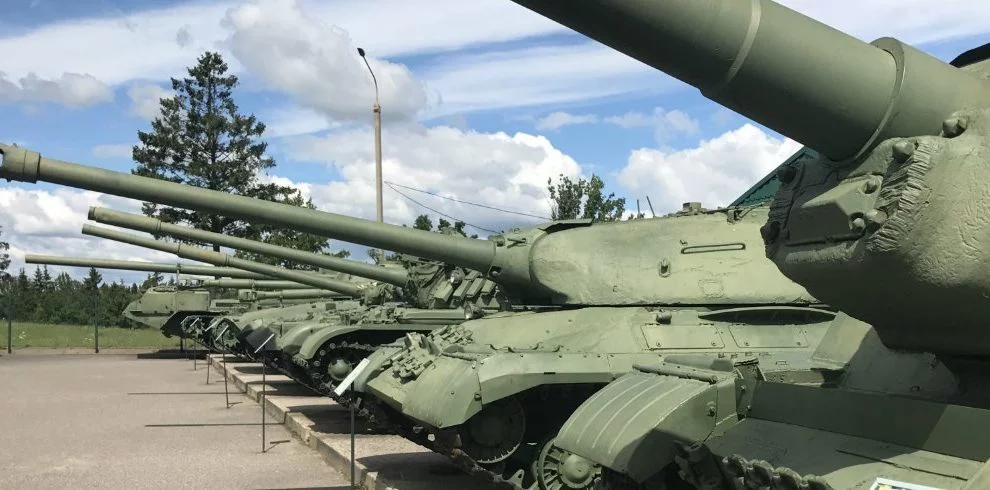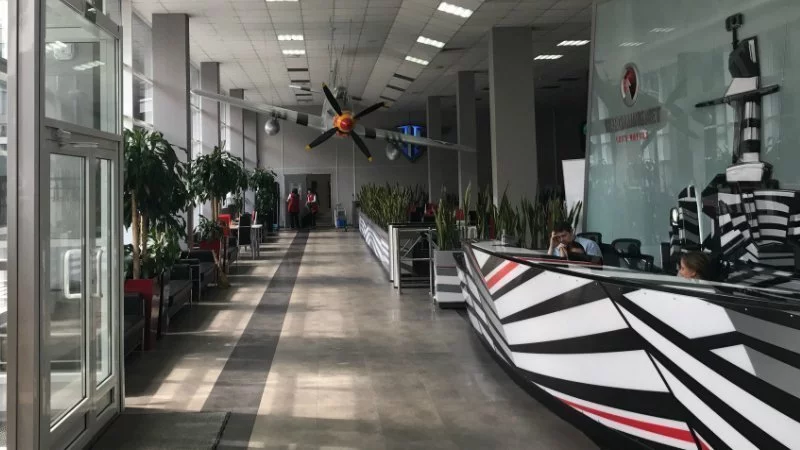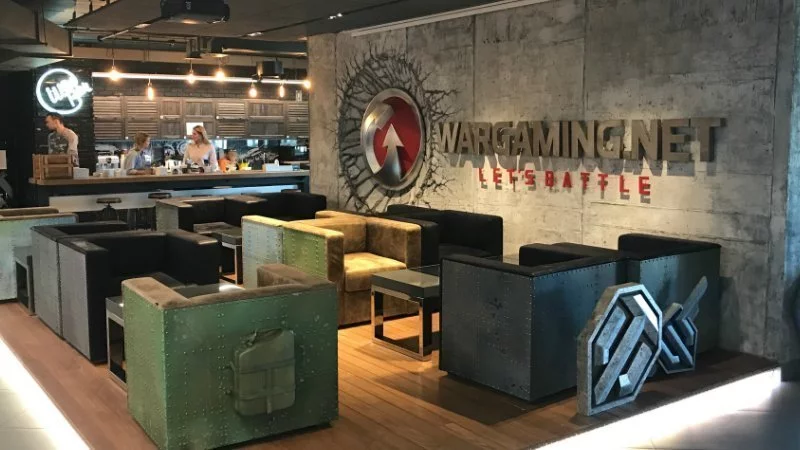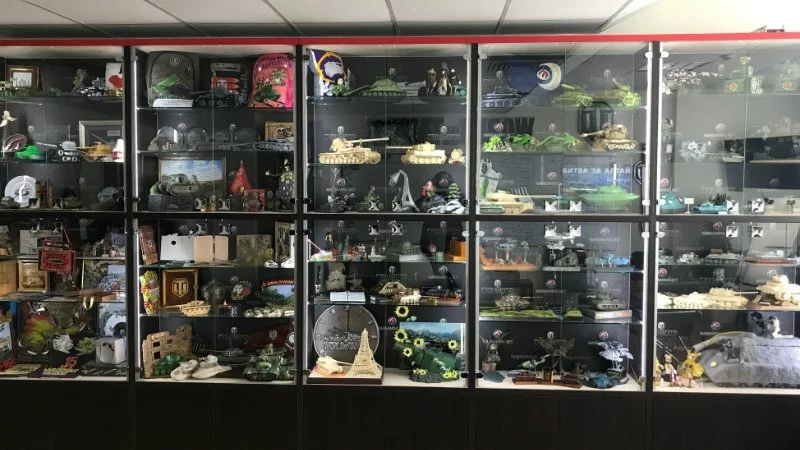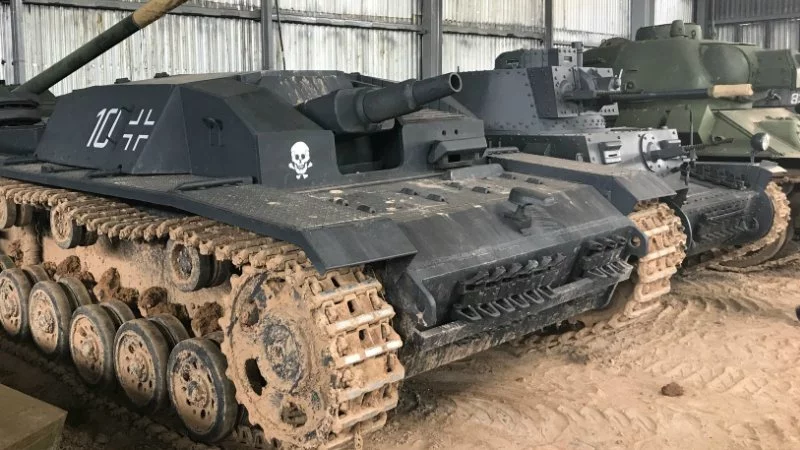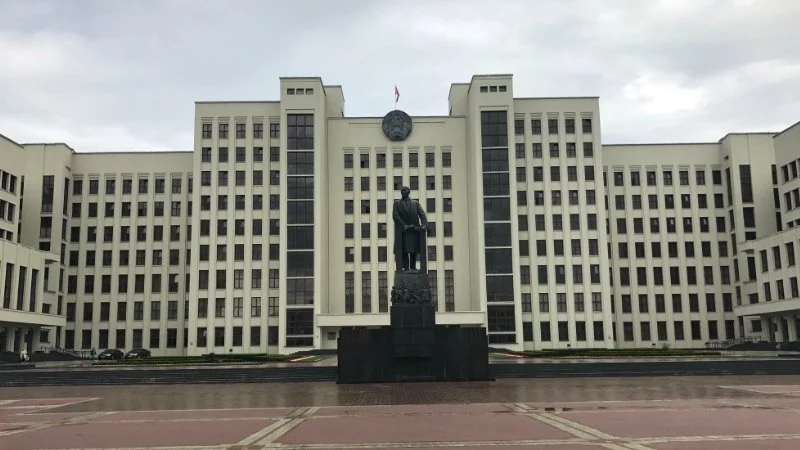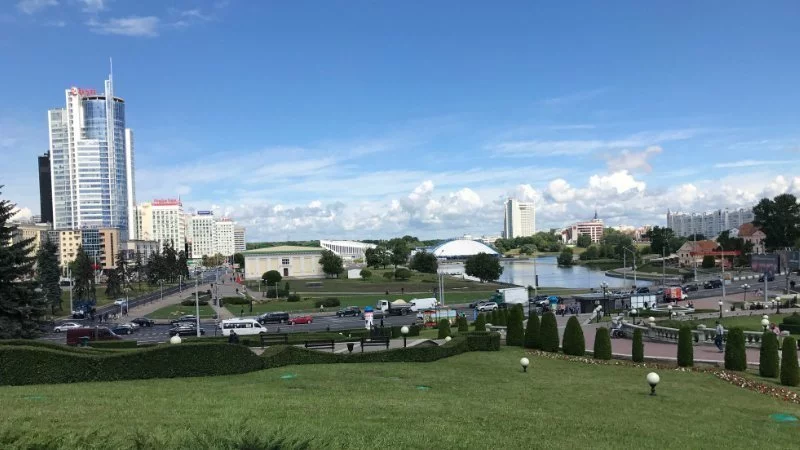The first stop in my three-day journey through Belarus was the Wargaming head office. Of their 4,000 employees, around 2,000 of them work out of the Minsk office and you can tell. This 16-story titan towers above the surrounding buildings. As soon as I entered I was greeted with an enormous desk shaped like a battleship. To my left, a giant plane hung from the ceiling; to the right, a tank. An actual tank! I was proudly told the steel monster was actually driven into the lobby, proving these guys love a bit of showmanship.
After some extensive tours of the various floors and offices, I came to one of the most interesting spots in the building. They have an entire room dedicated purely to gifts that they’ve received from fans. My favourite was a sword that was made by a local blacksmith. Apparently, he built the custom sword and just dropped it off at reception one day without leaving his name, a note — nothing. After some serious detective work they eventually tracked down the player so they could thank him for his contribution.
Another story that piqued my interest is the quest new employees are given when they joint the team at the Minsk office. There are many steps, much like a treasure hunt, but once the newbie finishes the quest it all culminates in the relaxation room on the twelfth floor. Behind certain letters in a mission statement on the wall are small compartments. If they manage to find the right one a present will be waiting for the skilled adventurer.
On the ground floor in the lobby — just below the huge airplane hanging from the ceiling — is the cafeteria. Employees are encouraged to eat here to promote an atmosphere of teamwork. This is made more likely by the fact that the food is excellent, easily accessed and cheap. In fact, the company pays for 50% of all employees meals.
After leaving the office I was treated to a traditional Georgian diner. The restaurant looked like a re-purposed house from the outside and was clearly very bold from the interior. Completely wooden scaffolding and high ceilings set the tone for the amazing meal that was served. I can’t even begin to describe — or name — the food but it’s was all delicious and I was fussed over by the Georgian family that owned and ran the restaurant. I’ll attempt a description of the traditional drinks though.
The hard stuff was a kind of vodka made from grapes. I was told it’s like and incredibly strong wine but it tasted just like vodka to me. They also served some traditional soft drinks flavoured with pair, cream — it was strange — and my personal favourite, as I called it, the green one.
The almost fluorescent green colour comes from the herbs in the drink. I wasn’t told what herbs, I assume it just didn’t translate so the fact that it had herbs in it was the only info I could get out of them. I looked a lot like absinthe and had the same aniseed smell to it but it was very sweet and easy to drink. Easier than the grape vodka anyway. After failing to eat a dumpling in an incredibly specific way — much to the distress of the owners — and embarrassing myself sufficiently it was time to call it a night.
Day two started out with trip to Hi-Tech Park and the beginning of my cultural education. Hi-Tech Park is Belarus’s answer to a serious problem that started manifesting earlier this century. By 2009 far too many of their educated youth were leaving the country for greener pastures.
The government stepped in and passed new laws and major tax cuts to encourage the younger generation to stay within the country and help boost the economy by creating new start up companies and therefore jobs. Coupled with the ever improving education present in the country, the problem was not only solved but completely flipped in less than 10 years. Belarus is now a booming centre for information technology that boasts an impressive number of success stories.
Now that I had a little culture under my belt, it was time to see some tanks and delve into history of battle in the region. My next stop was the Stalin Line Historical and Cultural Complex. Here I learned how the defences were set up, supported and maintained during World War II. I visited a bunker still set up in the way it would have been in the days it was used to repel German troops. I walked along a trench between two such bunkers and learned that they relied heavily on infantry support as they were stationary and wouldn’t last long against an invading tank without mobile defences.
I was then shown an impressive amount of anti-aircraft guns, armoured personnel carriers, machine guns and tanks. Wargaming has a fantastic relationship with the Stalin Line Historical and Cultural Complex among other historical venues and museums around the world. The publisher has a very active role in helping to revive and restore tanks from throughout history to working order and proudly display them at such facilities.
A few of the Wargaming staff told me that 4 years ago they had 2,000 of their employees celebrate the companies 15 year anniversary at the Stalin Line by holding a private party on site culminating in a performance by The Offspring! I can’t wait to hear how they top that in a year for their 20th anniversary.
After a tour and quick go at firing off some artillery it was time to go for a tank ride. What’s a trip to Minsk with Wargaming without riding a PT 76 tank, right? I’ll be honest: I was terrified. I actively avoid things that other humans claim to love (like roller coasters), so this was a big step for me. I’m happy to report however that I thoroughly enjoyed it. The highlight was launching over a three meter ramp and crashing to the mud with a satisfying thud. My knees were a little bruised but I was otherwise unscathed and happy to have had the experience.
After my teeth stopped rattling it was time for my first Belarus-style borscht and draniki, a kind of potato pancake served with sour cream — easily may favourite Belorussian dish — and, of course, some vodka. You may be noticing a trend. In a jovial mood I headed straight to the heart of Minsk and an old-fashioned English pub. The food was a little more familiar and while the turkey burger was interesting it hardly warrants a story. Filled with burgers and beers it was time to end day two.
Day three promised to be the most educational yet; I was looking forward to learning a little more about the city and country I was spending time in. The morning started with some rain for all of five minutes, clearing up just as I began my guided tour of the city. I learned how 80% of Minsk was destroyed during World War II. The surviving buildings were patched up while massive sections of the city were completely rebuilt. The government at the time explained to residents that restoration was too expensive for the broken buildings and so completely new ones would be constructed at a fraction of the cost. As a result, the modern city of Belarus is almost completely different from how it would have looked before the war.
The population suffered incredible losses too as around 30% of the country’s residents perished during World War II. Belorussians take a lot of pride — and rightly so — in the way they have rebuilt their city. There is very little modern architecture throughout the city and during the remodelling Saint Petersburg was a big inspiration. The sunny city law was passed through the governments town planning and ensured that and sun shine on a nice day won’t go to waste by limiting the height of buildings on each side of the road to half the width of the streets.
There is a beautiful park in the middle of the city named after a Belorussian 20th century poet, Yanka Kupala. The poet’s house has been turned into a museum of his work on the edge of the park. Just nearby is the incredible dome-shaped arts centre were all the city’s ballet and operas are performed and on the other side of the river is the site of the original wooden castle that the city grew from. This September, Minsk will celebrate the 950th anniversary of its first mention in historical records.
It was with this long history in mind I went to my next location the Belorussian Folk Museum of Architecture and Rural Life. This was a trip back in time like I’ve never experienced before. I was shown a 300-year-old church and told how two rival faiths were combined to keep the townsfolk and the Vatican happy. I saw wooden houses and barns used for storing both people and crops respectively just as they would have been hundreds of years earlier.
Once my time machine stopped it was time for another borscht and — you guessed it — a vodka. I actually had to ask for this one and explained that it had kind of become a tradition for me by this point. While packing my bags and readying myself for my flight home I reflected on all the things I had seen and the people I’d met.
Minsk in a beautiful, modern city surrounded by seemingly endless, lush forests. The people take immense pride in their country and have a deep respect for their very long history varying from peaceful farmers to formidable warriors. I tried not to have any expectations before my trip and yet I still managed to be completely surprised.
As of January this year the local government has made it easier for tourists to visit Belarus as you no longer require a visa if your stay is five days or less. I encourage anyone who is curious to take the plunge and visit Belarus for yourself. I would also like to thank Wargaming for thoroughly entertaining me during my stay and showing me the deep connection the company shares with the locals.
Stevivor was flown to Minsk as a guest of Wargaming.
This article may contain affiliate links, meaning we could earn a small commission if you click-through and make a purchase. Stevivor is an independent outlet and our journalism is in no way influenced by any advertiser or commercial initiative.























